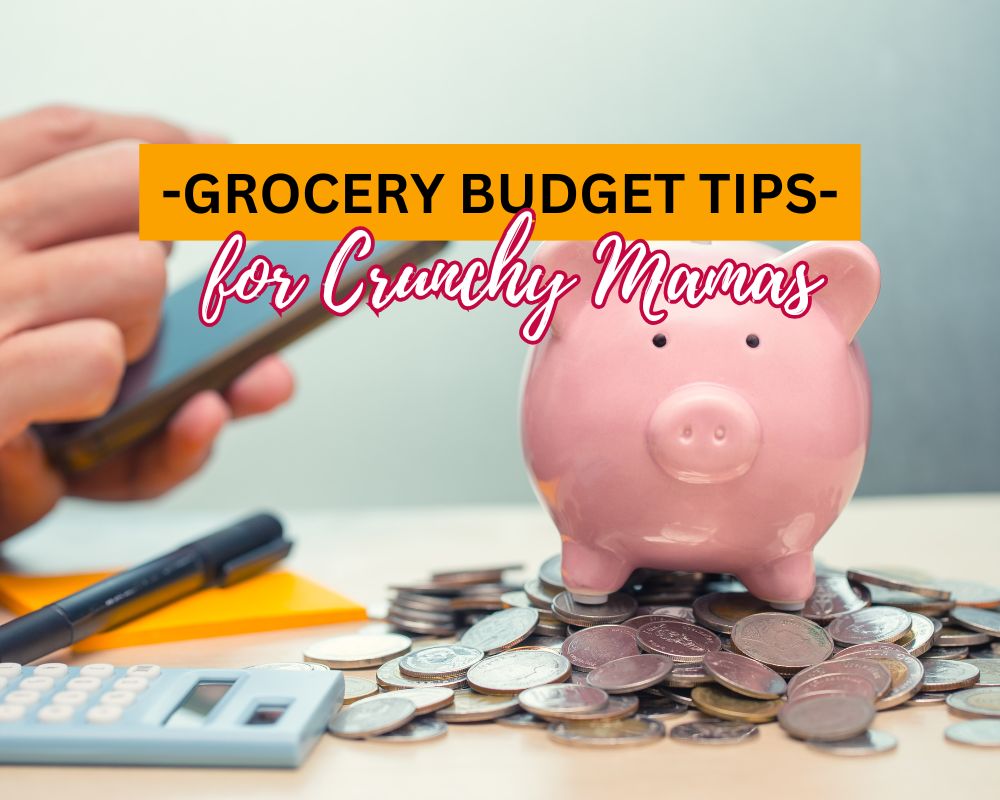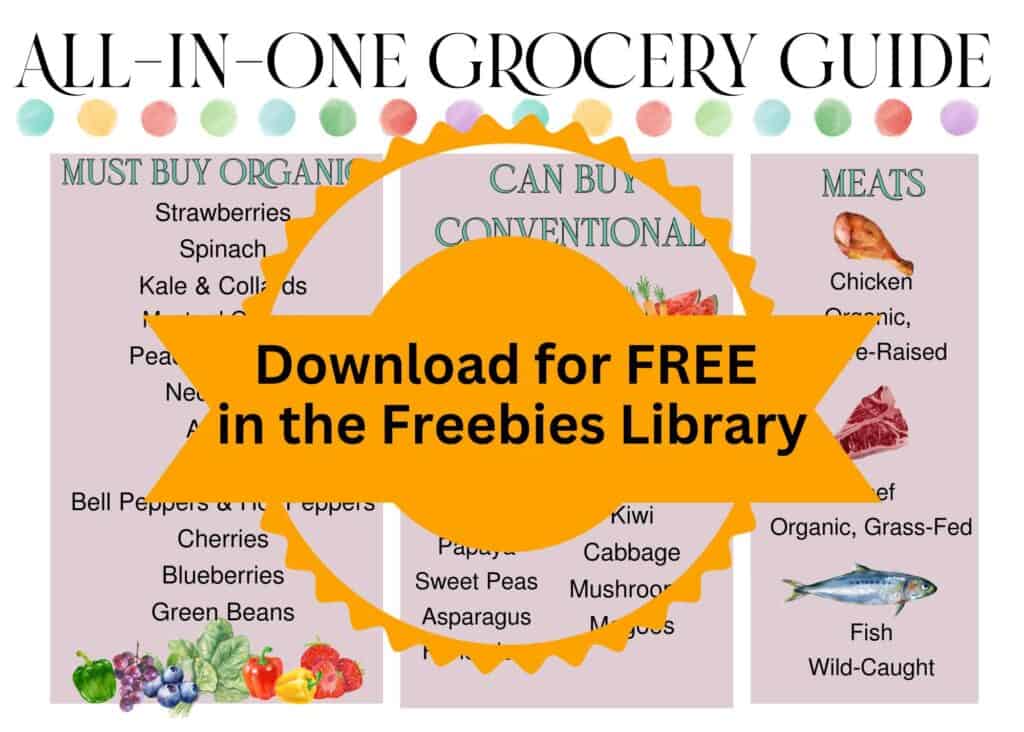Most of us Crunchy Mamas face the same dilemma at the grocery store. We want to feed our families well. We want real, whole foods, not processed junk. We want to avoid pesticides and give our kids the nutrients they need to grow healthy and strong. But have to think of the grocery budget. Buying all organic food seems impossible, and the cheap stuff is horrible for our health. So what’s a Diligent Mama to do? I’ve got a few tips for you that have helped feed my large family, so keep reading! And relax… I’m not going to tell you that you have to meal plan for the whole month or grow all of your own food!
(Affiliate links are included below. Please see my policies and disclaimers for more information.)
Tip #1: Find Quality Eggs for Protein & Cut Back on Meat
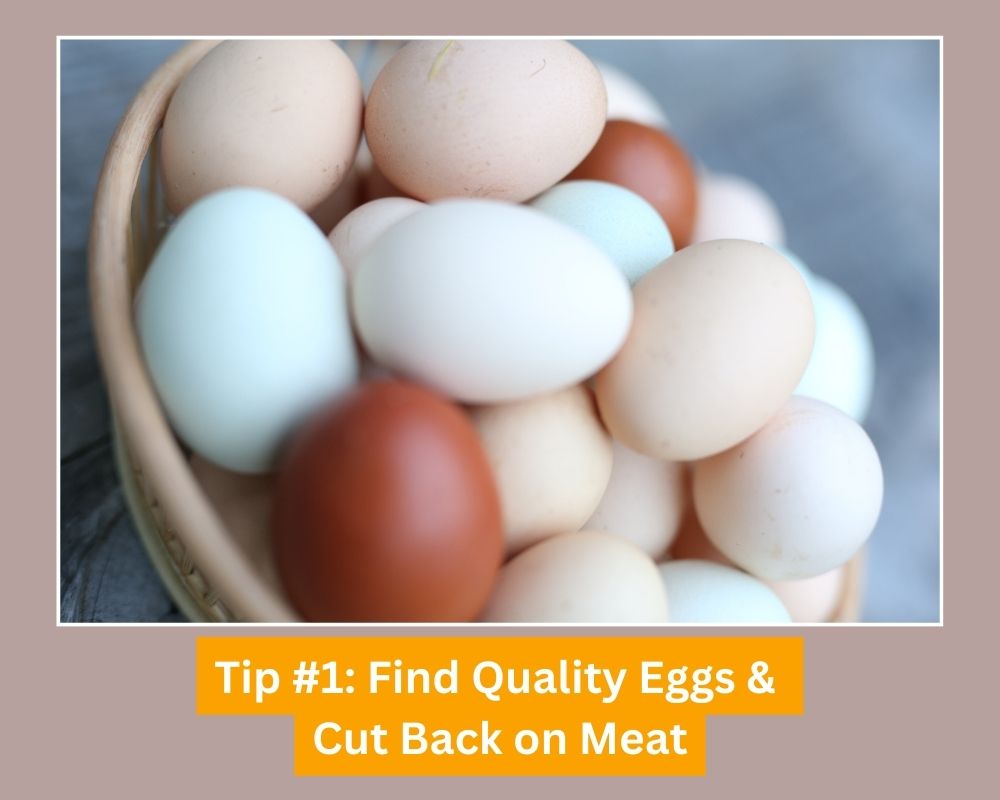
Don’t underestimate the power of an egg! Eggs can save you money by using them as a protein-packed side dish, which means you can serve a little less meat at meal time. For example, on air-fried chicken night, instead of my teenage son needing 2 pieces of chicken, he can be happy with one piece of chicken and a couple of eggs. Meat is usually the biggest chunk of your grocery budget, so this trick can save money fast!
I use my egg cooker to hard-boil about 2 dozen eggs per week. If I’m in a hurry, I’ll just grab a boiled egg from the fridge, peel, and serve. Sometimes, I’ll make a batch of stuffed eggs, which are always a hit. Eggs are nutrient-dense and protein-packed. They contain amino acids, vitamins, and minerals that are great for your family (source). Try to buy from local farms or friends with chickens. Pastured hens lay much more nutritious eggs than confined, conventionally farmed hens (source).
Tip #2: Skip the Cereal, Granola Bars, and Yogurt

If you’re a Crunchy Mama, I’m guessing you’re skipping the cheaper cereals, granola bars, and yogurts. You aren’t interested in the Fruit Loops and their food colorings. You are trying to avoid the high fructose corn syrup in the granola bars. And the cheap yogurt with its massive amounts of sugar and artificial ingredients is a no-go for you.
That means that if you are buying these items for your family, you’re springing for the high-dollar, organic versions. And these items can bring the total cost of your grocery budget up FAST!
You can save a ton of money by making your own versions of these items at home! Instead of cereal and granola bars for breakfast, try Superfood Chocolate Chip Energy Balls (a favorite at my house!) or Sourdough Breakfast Brownies. And instead of pre-made yogurt, buy your own plain yogurt and mix it yourself. I love buying my yogurt from Costco. Bonus: Mixing your own yogurt lets you use sweeteners like local honey, and it’s also a great way to squeeze in a serving of fresh fruits. Here’s one recipe I use for mixing my own yogurt.
Tip #3: Buy Frozen

Buying frozen fruits and veggies can really help keep your food budget on track for four main reasons. First, did you know that the average American family of 4 throws away about $1,600 worth of produce per year (source)? What a waste of money! Buying frozen means the food is much less likely to go bad before you use it.
Second, fresh vegetables and fruits often cost more per ounce than the frozen version. I find this to be especially true when comparing organic fresh produce to organic frozen produce.
Third, you can buy bulk items when frozen to save money. For example, instead of buying one small carton of blueberries every week, you could purchase a large frozen bag of blueberries to last the whole month.
Fourth, having frozen options on hand makes last-minute dinner options happen! Even when I haven’t planned well, I usually have something I can pull together fast. Grabbing some frozen veggies out of the freezer to serve with frozen chicken is such a healthier and more budget-friendly option than grabbing take-out. The best part is saving chopping time when I use frozen veggies!
And here’s a bonus when it comes to frozen versus fresh…According to a 2-year study published in the Journal of Food Comparison and Analysis, frozen fruits and veggies contain more nutritional value long-term than fresh versions. They found that after just 5 days of refrigeration, produce began to lose nutritional value.
Tip #4: Make Your Own Bone Broth
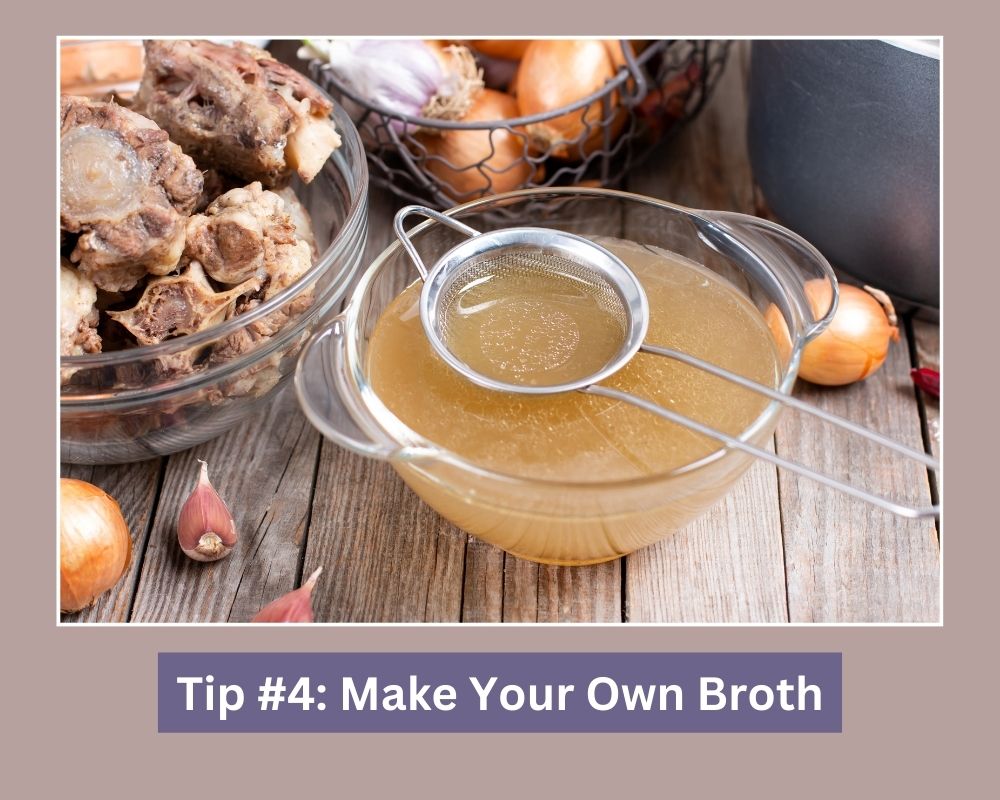
Once you see how easy it is to make your own bone broth, you’ll NEVER need to buy any from the store again. Simply save the bones you were going to trash and follow this simple recipe. I promise, if you can make a peanut butter & jelly sandwich, you can do this!
A warm soup made with homemade broth is incredibly nutritious (source), freezes well, and is budget friendly! My family loves chicken soup with frozen veggies tossed in (remember Tip #3?).
Tip #5: Don’t Buy Organic Everything
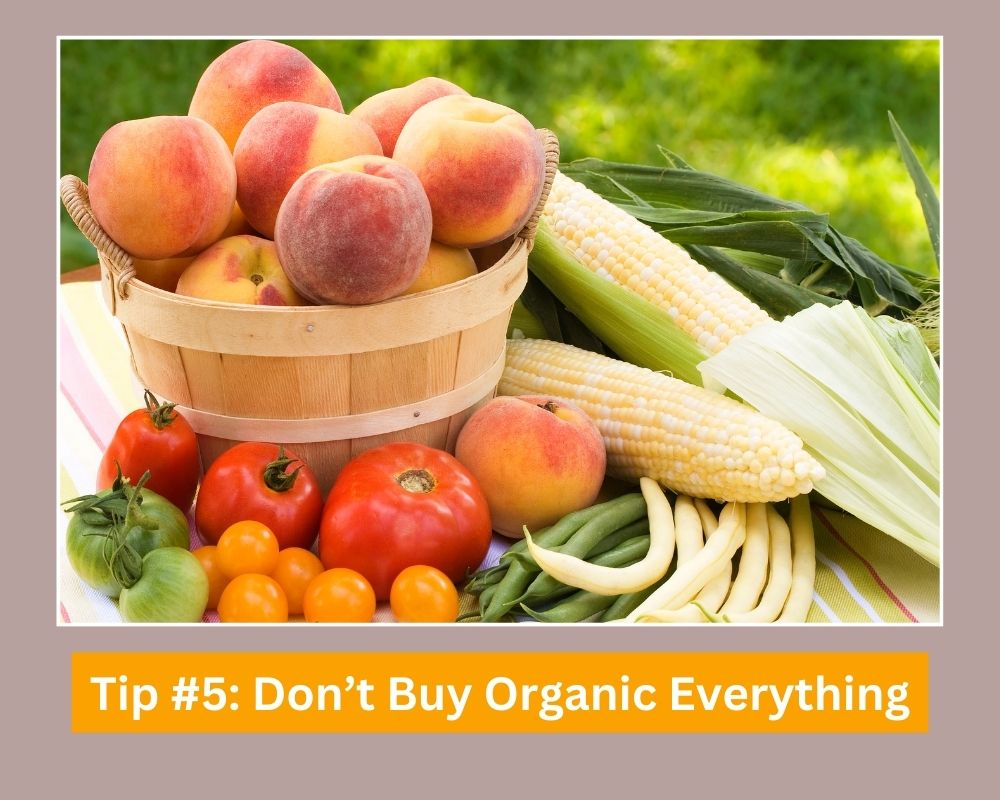
There is no way around it…organic costs more. However, some studies suggest that an organic diet leads to less chronic disease (source), less exposure to pesticides (source), and even a reduced risk of cancer (source). So, clearly it matters.
Moms often find themselves struggling with the desire to buy organic, but the higher price tag holds them back. This crossroads is where the EWG’s (Environmental Working Group) Dirty Dozen and Clean 15 Lists come is so handy! Every year the EWG samples a variety of fruits and vegetables to check for pesticides. The Dirty Dozen are the 12 most pesticide-contaminated produce items they found. I ONLY buy these 12 produce items in their organic forms. If organic is unavailable or too pricey, I just pick a different produce that week.
In contrast, the Clean 15 are the 15 cleanest produce items they tested containing very few pesticides. I feel safe buying the conventional rather than organic forms of these produce items and saving money where I can.
I’ve got a handy FREE printable for Members in my Freebies Library that contains the Dirty Dozen and Clean 15. I refer to it often when I’m grocery shopping.
Tip #6: Skip Buying Drinks
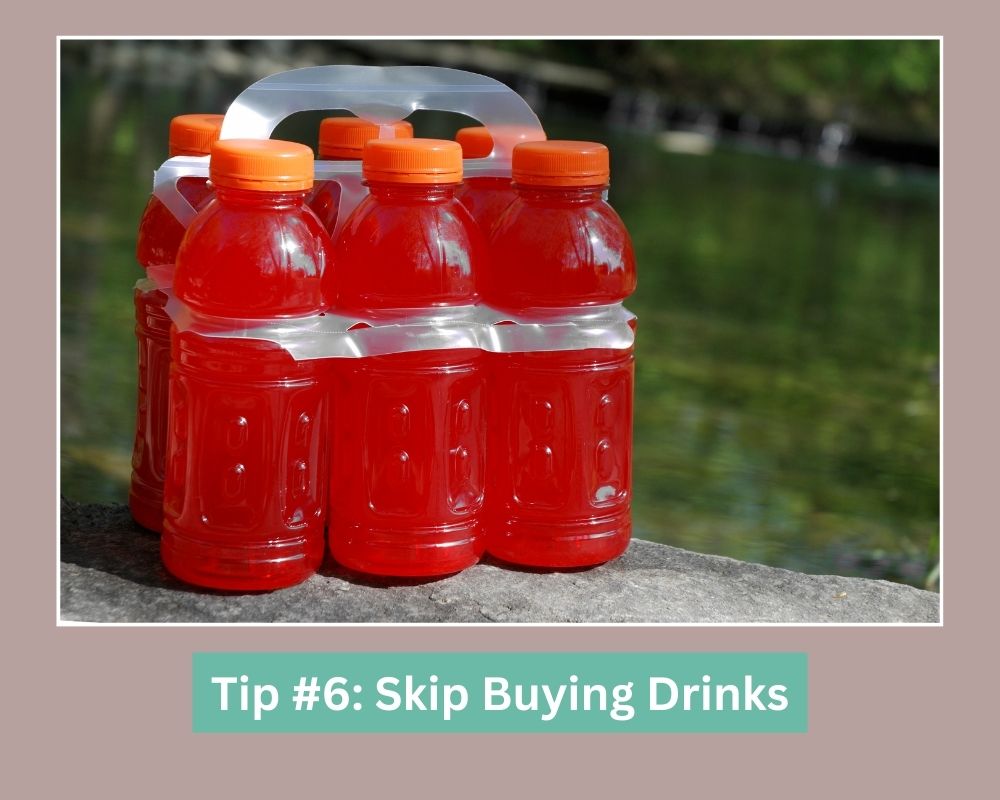
You can slash your grocery budget and save so much money if you’ll just stop buying bottled/canned drinks. Soft drinks, bottled coffees and teas, energy drinks, juice, or even Gatorade…most of these drink options are not good for your health anyway, so why spend part of your grocery budget on them? At the end of the day, there are so many better options out there!
Homemade green tea is of my favorite things, it’s great for your health (source), and it costs less than 25 cents per serving. I’ll show you how I make it and a few other alternative drink options in this article.
Tip #7: Buy in Bulk

I have written in my Costco series about how much money we are saving each month by getting what we can there. The first time I shopped Costco, I was shocked at how many organic and nutritious options they carry! For whatever reason, I had assumed that big box stores simply wouldn’t offer the kinds of products I wanted for my family. Boy, was I wrong!
I buy bulk staples there like organic flour and olive oil. I also buy packable lunch box options like Clif Kid Bars. They have ready meats perfect for lunches like cans of wild-caught tuna (43 grams of protein per can!) and grass-fed Polish sausages. And I even stock up on household basics like toilet paper!
Tip #8: Make Your Own Bread

A lot of people don’t realize how easy it is to make bread and how much it can save you. Making bread is really not hard, especially if you have a stand mixer to help you out. I’ve shared my recipe for Healthy Homemade Sandwich Bread here.
Before I started making my own bread, I was purchasing 2 loaves of Dave’s Killer Bread per week. Now that I make my own bread (using that bulk flour from Costco that I mentioned in Tip #7), I save my family about $40 per month on bread alone! Your taste buds will thank you, too…there’s just nothing better than homemade bread!
Tip # 9: Buy a Cow Directly from a Farmer

Now, I understand that this tip might be out of reach for some budgets, but hear me out! Most farmers give the option of purchasing a half cow or a whole cow. What if you purchased a half cow, and split it with 3 friends? That would bring the cost of investing in the meat way down!
If you purchase directly from a farmer, not only will you get the best quality ground beef, steak, and roasts possible, you’ll get all of the extras for no additional cost! Let me explain. When you purchase the cow, you pay for the hanging weight. This price per pound includes the bones, organs, and fat. Most people don’t request that the butcher saves those parts, so they are discarded. But not a Diligent, budget-conscious Mama! We want it all!
We know that we can use those bones to make the best broth around for our families! We know that we can ask the butcher to grind the organs, then we can include a scoop of organ meat in any meat dish we are cooking (I put some in my spaghetti just last night…There are many different ways to use it!). And we know that the fat makes great tallow that can be used for skin care or even cooking! Side note- Have you seen my recipe for Whipped Face Tallow? That stuff is the best!
Bottom line…investing in a half cow gives you way more than just high quality meat! And sometimes, if the customer buying the other half of your cow doesn’t want their bones, organs, or fat, the butcher may give it ALL to you. Talk about amazing freebies!
Tip #10: Buy Raw Milk
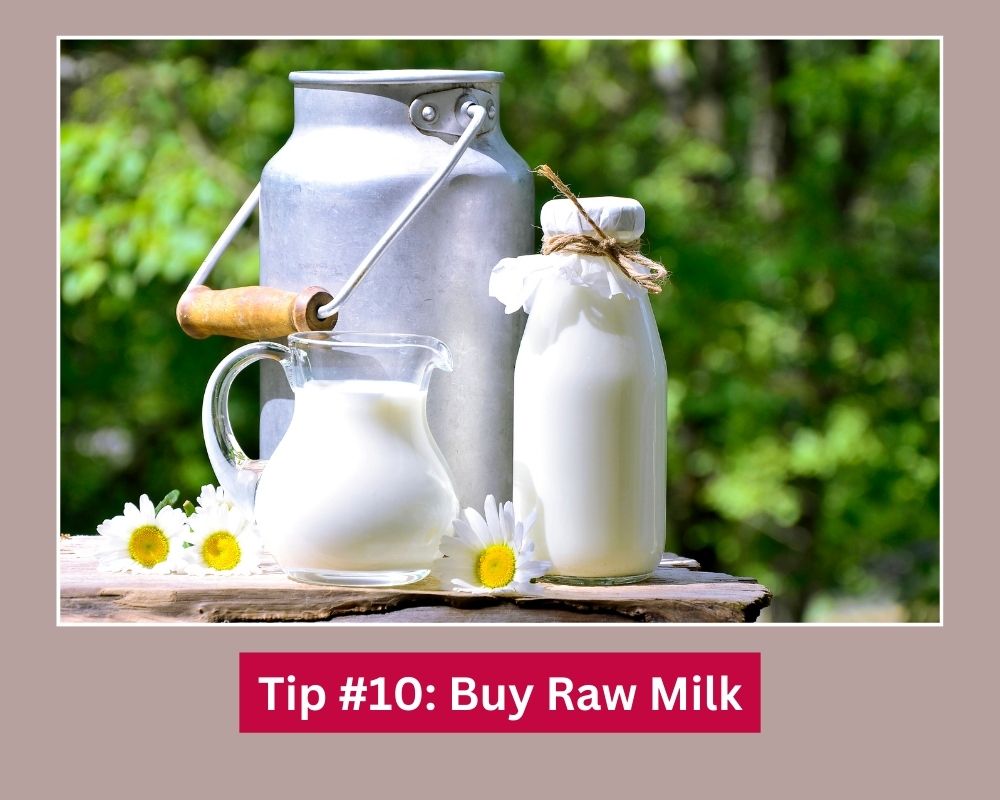
Yes, raw milk costs more than conventional milk. So, exactly how is this swap going to help your budget? Once I was able to get my hands on raw milk for my kids, I felt like I no longer needed to give them a multivitamin. Multivitamins, especially the good-quality ones are expensive! But raw milk delivers vitamins, calcium, iron, minerals, protein, enzymes, and beneficial bacteria all while helping to meet their caloric needs. I felt like I could deliver all of that goodness to my kids in the form of real food, not synthetic vitamins. I’ve written more about the benefits and safety of raw milk here.
In a nutshell, raw milk helps your overall budget by killing two birds with one stone. So, if you haven’t tried it, it might be a good time to look for a raw milk source in your area! This raw milk finder can help. And if you need to sweeten the deal with chocolate milk, I’ve got a great post about Homemade Healthy Hershey’s Syrup that your kids will love!
Final Thoughts about Saving Money on Your Grocery Budget
If you’ve hung with me this far, let me give you a big hug….you’re an amazing Mama. You are committed to finding a way to helping your family get real food and stay away from affordable junk food. You see the value in taking the road less traveled, and you’re searching for solutions to serve your family well. That’s amazing! That’s diligent!

